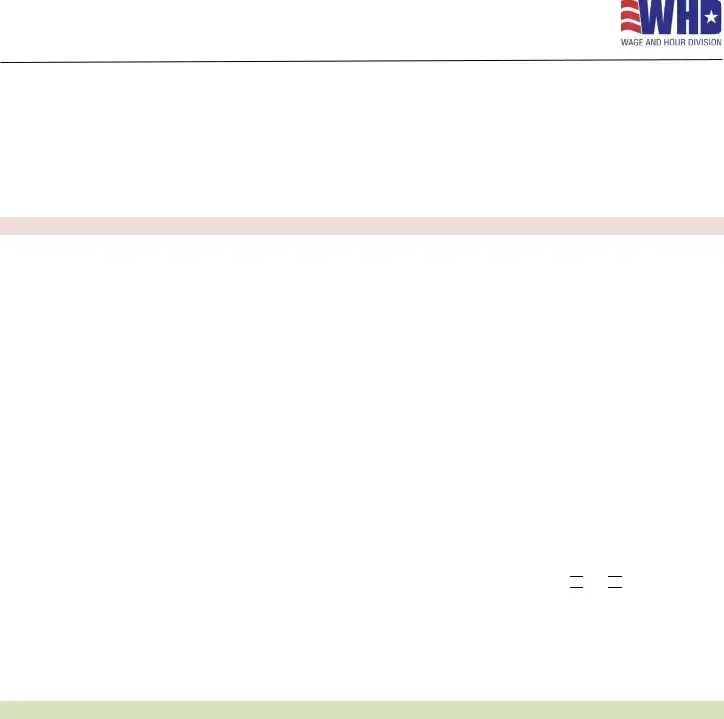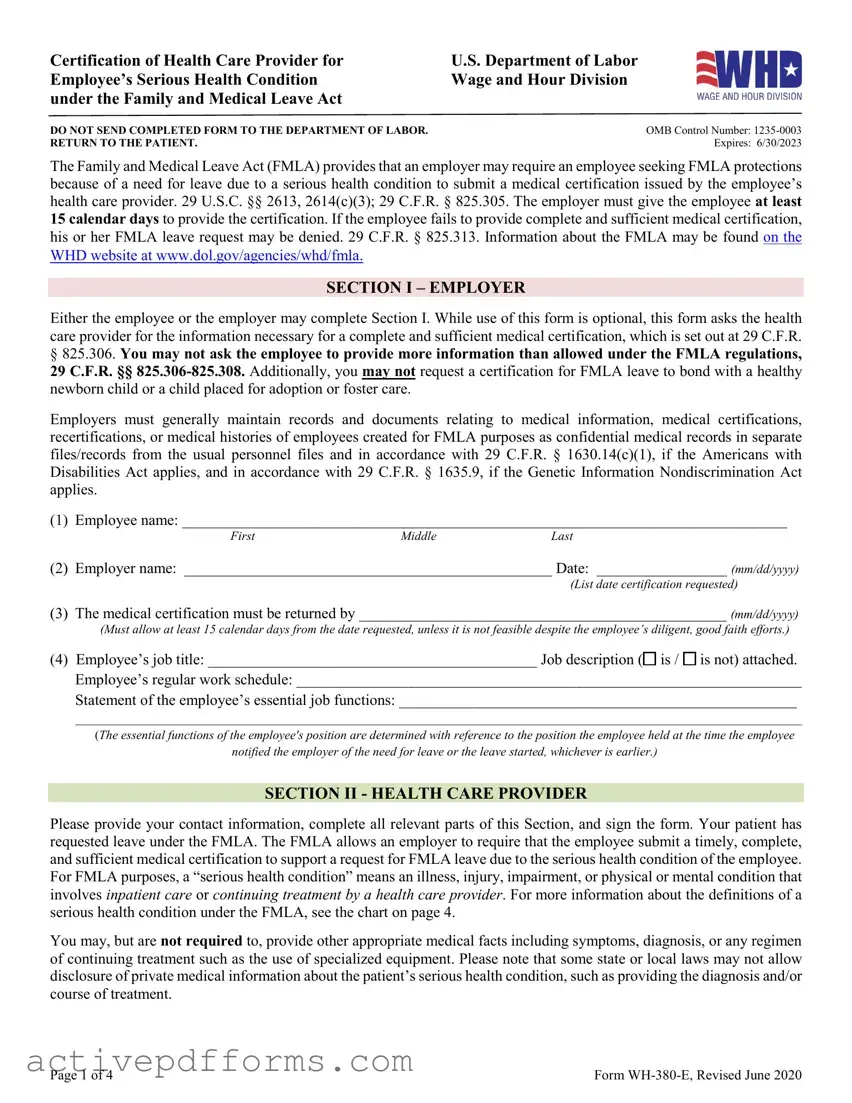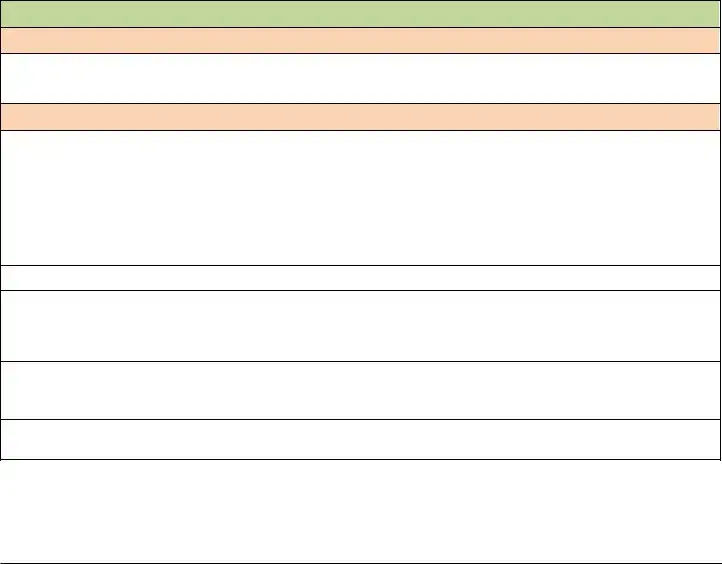
Certification of Health Care Provider for |
U.S. Department of Labor |
Employee’s Serious Health Condition |
Wage and Hour Division |
under the Family and Medical Leave Act |
|
DO NOT SEND COMPLETED FORM TO THE DEPARTMENT OF LABOR. |
OMB Control Number: 1235-0003 |
RETURN TO THE PATIENT. |
Expires: 6/30/2023 |
The Family and Medical Leave Act (FMLA) provides that an employer may require an employee seeking FMLA protections because of a need for leave due to a serious health condition to submit a medical certification issued by the employee’s health care provider. 29 U.S.C. §§ 2613, 2614(c)(3); 29 C.F.R. § 825.305. The employer must give the employee at least 15 calendar days to provide the certification. If the employee fails to provide complete and sufficient medical certification, his or her FMLA leave request may be denied. 29 C.F.R. § 825.313. Information about the FMLA may be found on the WHD website at www.dol.gov/agencies/whd/fmla.
SECTION I – EMPLOYER
Either the employee or the employer may complete Section I. While use of this form is optional, this form asks the health care provider for the information necessary for a complete and sufficient medical certification, which is set out at 29 C.F.R.
§825.306. You may not ask the employee to provide more information than allowed under the FMLA regulations, 29 C.F.R. §§ 825.306-825.308. Additionally, you may not request a certification for FMLA leave to bond with a healthy newborn child or a child placed for adoption or foster care.
Employers must generally maintain records and documents relating to medical information, medical certifications, recertifications, or medical histories of employees created for FMLA purposes as confidential medical records in separate files/records from the usual personnel files and in accordance with 29 C.F.R. § 1630.14(c)(1), if the Americans with Disabilities Act applies, and in accordance with 29 C.F.R. § 1635.9, if the Genetic Information Nondiscrimination Act applies.
(1) |
Employee name: _______________________________________________________________________________ |
|
First |
Middle |
Last |
(2) |
Employer name: ________________________________________________ Date: _________________ (mm/dd/yyyy) |
|
|
|
(List date certification requested) |
(3) |
The medical certification must be returned by ________________________________________________ (mm/dd/yyyy) |
(Must allow at least 15 calendar days from the date requested, unless it is not feasible despite the employee’s diligent, good faith efforts.)
(4)Employee’s job title: ___________________________________________ Job description (
 is /
is / 
 is not) attached.
is not) attached.
Employee’s regular work schedule: __________________________________________________________________
Statement of the employee’s essential job functions: ____________________________________________________
____________________________________________________________________________________________________________________
(The essential functions of the employee's position are determined with reference to the position the employee held at the time the employee
notified the employer of the need for leave or the leave started, whichever is earlier.)
SECTION II - HEALTH CARE PROVIDER
Please provide your contact information, complete all relevant parts of this Section, and sign the form. Your patient has requested leave under the FMLA. The FMLA allows an employer to require that the employee submit a timely, complete, and sufficient medical certification to support a request for FMLA leave due to the serious health condition of the employee. For FMLA purposes, a “serious health condition” means an illness, injury, impairment, or physical or mental condition that involves inpatient care or continuing treatment by a health care provider. For more information about the definitions of a serious health condition under the FMLA, see the chart on page 4.
You may, but are not required to, provide other appropriate medical facts including symptoms, diagnosis, or any regimen of continuing treatment such as the use of specialized equipment. Please note that some state or local laws may not allow disclosure of private medical information about the patient’s serious health condition, such as providing the diagnosis and/or course of treatment.
Page 1 of 4 |
Form WH-380-E, Revised June 2020 |
Employee Name: ____________________________________________________________________________________________
Health Care Provider’s name: (Print) ____________________________________________________________________
Health Care Provider’s business address: ________________________________________________________________
Type of practice / Medical specialty: ___________________________________________________________________
Telephone: (___) ______________ Fax: (___) ______________ E-mail: _______________________________________
PART A: Medical Information
Limit your response to the medical condition(s) for which the employee is seeking FMLA leave. Your answers should be your best estimate based upon your medical knowledge, experience, and examination of the patient. After completing Part A, complete Part B to provide information about the amount of leave needed. Note: For FMLA purposes, “incapacity” means the inability to work, attend school, or perform regular daily activities due to the condition, treatment of the condition, or recovery from the condition. Do not provide information about genetic tests, as defined in 29 C.F.R. § 1635.3(f), genetic services, as defined in 29 C.F.R. § 1635.3(e), or the manifestation of disease or disorder in the employee’s family members, 29 C.F.R. § 1635.3(b).
(1)State the approximate date the condition started or will start: ___________________________________ (mm/dd/yyyy)
(2)Provide your best estimate of how long the condition lasted or will last: ____________________________________
(3)Check the box(es) for the questions below, as applicable. For all box(es) checked, the amount of leave needed must be provided in Part B.
Inpatient Care: The patient ( has been / is expected to be) admitted for an overnight stay in a hospital,
hospice, or residential medical care facility on the following date(s): ______________________________
Incapacity plus Treatment: (e.g. outpatient surgery, strep throat)
Due to the condition, the patient ( has been / is expected to be) incapacitated for more than three consecutive, full calendar days from ______________ (mm/dd/yyyy) to _____________ (mm/dd/yyyy).
The patient ( was / will be) seen on the following date(s): _____________________________________
_______________________________________________________________________________________
The condition ( has / has not) also resulted in a course of continuing treatment under the supervision of a
health care provider (e.g. prescription medication (other than over-the-counter) or therapy requiring special equipment)
Pregnancy: The condition is pregnancy. List the expected delivery date: _______________ (mm/dd/yyyy).
Chronic Conditions: (e.g. asthma, migraine headaches) Due to the condition, it is medically necessary for the patient to have treatment visits at least twice per year.
Permanent or Long Term Conditions: (e.g. Alzheimer’s, terminal stages of cancer) Due to the condition, incapacity
is permanent or long term and requires the continuing supervision of a health care provider (even if active treatment is not being provided).
Conditions requiring Multiple Treatments: (e.g. chemotherapy treatments, restorative surgery) Due to the condition,
it is medically necessary for the patient to receive multiple treatments.
None of the above: If none of the above condition(s) were checked, (i.e., inpatient care, pregnancy) no additional information is needed. Go to page 4 to sign and date the form.
Page 2 of 4 |
Form WH-380-E, Revised June 2020 |

Employee Name: ____________________________________________________________________________________________
(4)If needed, briefly describe other appropriate medical facts related to the condition(s) for which the employee seeks FMLA leave. (e.g., use of nebulizer, dialysis) _______________________________________________________
_____________________________________________________________________________________
PART B: Amount of Leave Needed
For the medical condition(s) checked in Part A, complete all that apply. Several questions seek a response as to the frequency or duration of a condition, treatment, etc. Your answer should be your best estimate based upon your medical knowledge, experience, and examination of the patient. Be as specific as you can; terms such as “lifetime,” “unknown,” or “indeterminate” may not be sufficient to determine FMLA coverage.
(5)Due to the condition, the patient ( had / will have) planned medical treatment(s) (scheduled medical visits) (e.g. psychotherapy, prenatal appointments) on the following date(s): ___________________________________________
_____________________________________________________________________________________________
(6)Due to the condition, the patient ( was / will be) referred to other health care provider(s) for evaluation or treatment(s).
State the nature of such treatments: (e.g. cardiologist, physical therapy) ________________________________________
Provide your best estimate of the beginning date ________________ (mm/dd/yyyy) and end date ________________
(mm/dd/yyyy) for the treatment(s).
Provide your best estimate of the duration of the treatment(s), including any period(s) of recovery (e.g. 3 days/week)
_____________________________________________________________________________________________
(7)Due to the condition, it is medically necessary for the employee to work a reduced schedule.
Provide your best estimate of the reduced schedule the employee is able to work. From ____________________
(mm/dd/yyyy) to __________________ (mm/dd/yyyy) the employee is able to work: (e.g., 5 hours/day, up to 25 hours a week)
_____________________________________________________________________________________________
(8)Due to the condition, the patient ( was / will be) incapacitated for a continuous period of time, including any time for treatment(s) and/or recovery.
Provide your best estimate of the beginning date ___________________ (mm/dd/yyyy) and end date
________________ (mm/dd/yyyy) for the period of incapacity.
(9)Due to the condition, it ( was / is / will be) medically necessary for the employee to be absent from work on an intermittent basis (periodically), including for any episodes of incapacity i.e., episodic flare-ups. Provide your best estimate of how often (frequency) and how long (duration) the episodes of incapacity will likely last.
Over the next 6 months, episodes of incapacity are estimated to occur ___________________________ times per (
 day /
day / 
 week /
week / 
 month) and are likely to last approximately ______________ (
month) and are likely to last approximately ______________ (
 hours /
hours / 
 days) per episode.
days) per episode.
Page 3 of 4 |
Form WH-380-E, Revised June 2020 |
Employee Name: ____________________________________________________________________________________________
PART C: Essential Job Functions
If provided, the information in Section I question #4 may be used to answer this question. If the employer fails to provide a statement of the employee’s essential functions or a job description, answer these questions based upon the employee’s own description of the essential job functions. An employee who must be absent from work to receive medical treatment(s), such as scheduled medical visits, for a serious health condition is considered to be not able to perform the essential job functions of the position during the absence for treatment(s).
(10)Due to the condition, the employee ( was not able / is not able / will not be able) to perform one or more of the essential job function(s). Identify at least one essential job function the employee is not able to perform:
_____________________________________________________________________________________________
_____________________________________________________________________________________________
Signature of
Health Care Provider _____________________________________________ Date _________________ (mm/dd/yyyy)
Definitions of a Serious Health Condition (See 29 C.F.R. §§ 825.113-.115)
Inpatient Care
•An overnight stay in a hospital, hospice, or residential medical care facility.
•Inpatient care includes any period of incapacity or any subsequent treatment in connection with the overnight stay.
Continuing Treatment by a Health Care Provider (any one or more of the following)
Incapacity Plus Treatment: A period of incapacity of more than three consecutive, full calendar days, and any subsequent treatment or period of incapacity relating to the same condition, that also involves either:
OTwo or more in-person visits to a health care provider for treatment within 30 days of the first day of incapacity unless extenuating circumstances exist. The first visit must be within seven days of the first day of incapacity; or,
OAt least one in-person visit to a health care provider for treatment within seven days of the first day of incapacity, which results in a regimen of continuing treatment under the supervision of the health care provider. For example, the health provider might prescribe a course of prescription medication or therapy requiring special equipment.
Pregnancy: Any period of incapacity due to pregnancy or for prenatal care.
Chronic Conditions: Any period of incapacity due to or treatment for a chronic serious health condition, such as diabetes, asthma, migraine headaches. A chronic serious health condition is one which requires visits to a health care provider (or nurse supervised by the provider) at least twice a year and recurs over an extended period of time. A chronic condition may cause episodic rather than a continuing period of incapacity.
Permanent or Long-term Conditions: A period of incapacity which is permanent or long-term due to a condition for which treatment may not be effective, but which requires the continuing supervision of a health care provider, such as Alzheimer’s disease or the terminal stages of cancer.
Conditions Requiring Multiple Treatments: Restorative surgery after an accident or other injury; or, a condition that would likely result in a period of incapacity of more than three consecutive, full calendar days if the patient did not receive the treatment.
PAPERWORK REDUCTION ACT NOTICE AND PUBLIC BURDEN STATEMENT
If submitted, it is mandatory for employers to retain a copy of this disclosure in their records for three years. 29 U.S.C. § 2616; 29 C.F.R. § 825.500. Persons are not required to respond to this collection of information unless it displays a currently valid OMB control number. The Department of Labor estimates that it will take an average of 15 minutes for respondents to complete this collection of information, including the time for reviewing instructions, searching existing data sources, gathering and maintaining the data needed, and completing and reviewing the collection of information. If you have any comments regarding this burden estimate or any other aspect of this collection information, including suggestions for reducing this burden, send them to the Administrator, Wage and Hour Division, U.S. Department of Labor, Room S-3502, 200 Constitution Avenue, N.W., Washington, D.C. 20210.
DO NOT SEND COMPLETED FORM TO THE DEPARTMENT OF LABOR. RETURN TO THE PATIENT.
Page 4 of 4 |
Form WH-380-E, Revised June 2020 |



 is /
is / 
 is not) attached.
is not) attached.

 day /
day / 
 week /
week / 
 month) and are likely to last approximately ______________ (
month) and are likely to last approximately ______________ (
 hours /
hours / 
 days) per episode
days) per episode